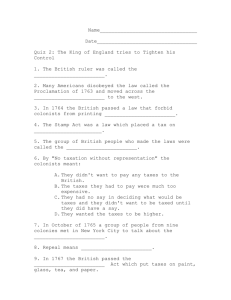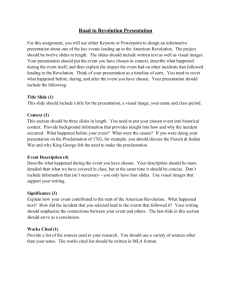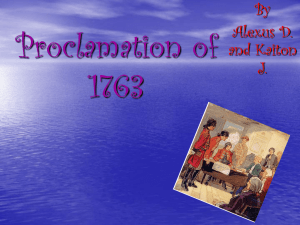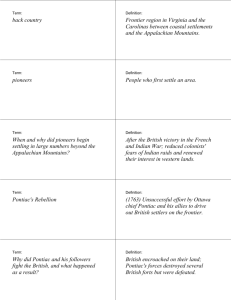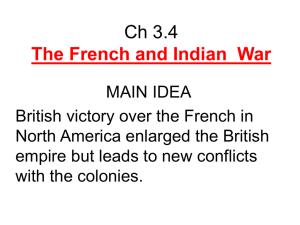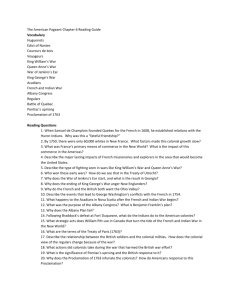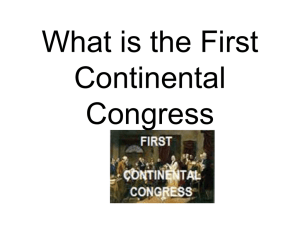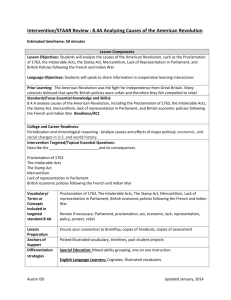Kelsey Denham SOCIAL STUDIES UNIT PLAN Title of Unit
advertisement
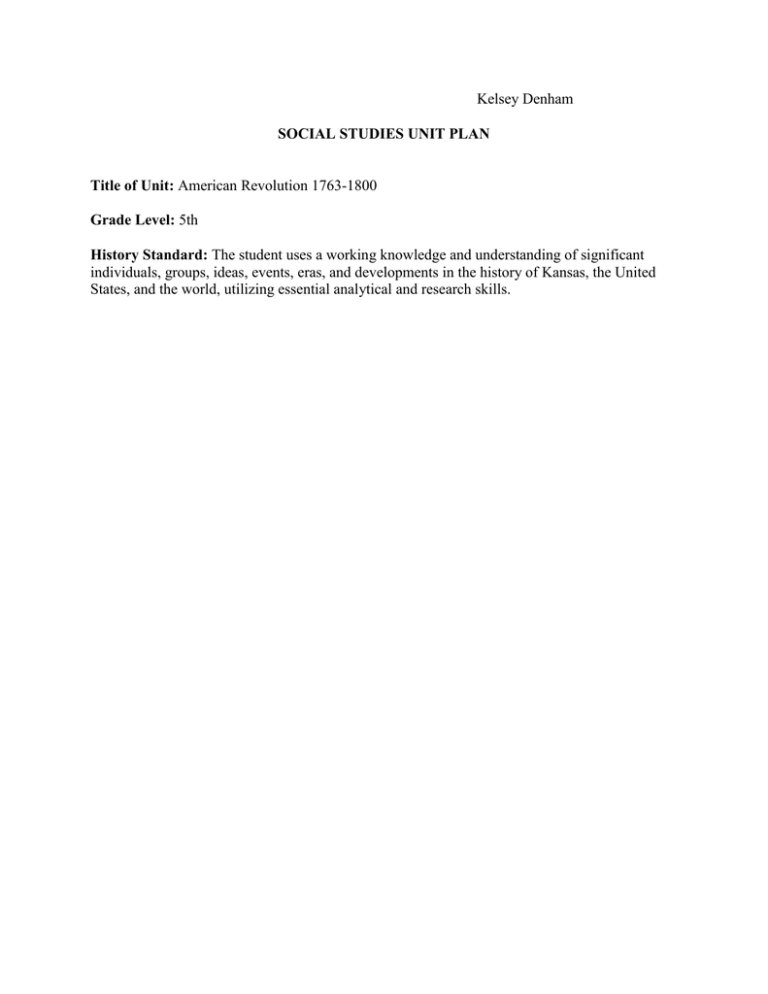
Kelsey Denham SOCIAL STUDIES UNIT PLAN Title of Unit: American Revolution 1763-1800 Grade Level: 5th History Standard: The student uses a working knowledge and understanding of significant individuals, groups, ideas, events, eras, and developments in the history of Kansas, the United States, and the world, utilizing essential analytical and research skills. Lesson Plans Lesson #1: The Proclamation of 1763 Benchmark: Benchmark 3: The student uses a working knowledge and understanding of individuals, groups, ideas, developments, and turning points in the American Revolution and the United Stated becoming a nation (1763-1800). Indicator 1: Describe the causes of the American Revolution (e.g., Proclamation of 1763, Intolerable Acts, Stamp Act, and Taxation without representation.) Objective: The students will be able to describe how the Proclamation of 1763 affected the radicals, loyalists, and moderates. They will also explain how the Proclamation of 1763 became a major leading cause of the Revolutionary war. They will know and comprehend all related vocabulary. Materials: Dictionary, Atlas, Pencils, Colored Pencils, Vocabulary Journals, Attached Documents, Background Information, Map, Worksheets, Vocabulary List, computer with internet access. Anticipatory Set: To introduce the unit I will ask the kids what they know about the American Revolution. Then I will have them draw a picture of what they think about when they hear the words “American Revolution.” I will also ask them what they would like to know in regards to the American Revolution. To introduce this specific lesson I will tell them that today we will be talking about the Proclamation of 1763 and will I will provide them with a little bit of background information about what lead to the proclamation. Instruction/ Modeling: Pass out all worksheets and information. Review the vocabulary (Stunning, Vast, Uprising, Struggle, Eliminate, Revenge, Envy, and Humiliate). Start the popcorn reading. Assign the students their groups for map worksheet. Check for Comprehension: Who wrote the Proclamation of 1763? How much war debt did England have when the Proclamation was written? Did the colonists follow the Proclamation of 1763? Guided Practice: The students will read the Proclamation of 1763 facts sheet out loud as a class by popcorn reading. After each reader we will discuss what the student has read and they will be asked how they would feel if they were in the colonists’ position. After reading and discussion the students will work in their table groups on the map assignment (see attached) where they will color the original 13 colonies in one color, the other British territory in another color, and the Spanish territory in another color. By using information that the they already know or through research on the internet they will find these locations. Independent Practice: The students will complete the Proclamation of 1763 worksheet that will go over their vocabulary and have several questions about the proclamation. They will be able to use their facts sheet for help for 3 minutes at the end of the independent practice. Closure: Students will come together after they have finished their worksheets. We will then talk about what they learned by reading the Proclamation, and they will put themselves in the shoes of the Colonists, Indians, and British and will say how they felt about the Proclamation of 1763. Evaluation of the Student Performance Objectives: I will take the Proclamation of 1763 worksheet and will score them based on accuracy. The Proclamation of 1763 Vocabulary: Match the word with the correct definition. 1. Uprising ashamed. 2. Struggle 3. Vast 4. Stunning 5. Eliminate 6. Revenge 7. Humiliate 8. Envy a) To lower the pride, dignity or self-respect; make b) To do harm in return for a wrong doing c) A revolt; rebellion d) Very great; immense e) To try hard; work against difficulties f) Shocking; bewildering g) To get rid of; remove h) A desire because another person has what you want True or False: Mark each statement T for true or F for false. 9. With the signing of the Treaty of Paris in 1763, France’s influence was eliminated from North America.________ 10. Chief Moscow led an Indian uprising in 1763.________ 11. No settlers would be allowed west of the Allegheny Mountains after the Proclamation of 1763.________ 12. The land east of the Alleghenies would be Indian hunting grounds.________ 13. The colonies followed the Proclamation 1763, moved out of the Ohio country, and were happy about it._________ Short Answer: Answer each question with at least 2 sentences. 14. How did the proclamation affect the: a. Loyalists: b. Radicals: c. Moderates: 15. After reading the article, what do you predict will happen with the colonists? Lesson Number 2 Title: American Revolution Monarchy Activity Benchmarks and Indicators: Benchmark 4: The student engages in historical thinking skills. Indicator 5: Observes and draws conclusions. Benchmark 3: The students use a working knowledge and understanding of individuals, groups, ideas, developments, and turning points in the American Revolution and the United States becoming a nation (1763-1800) Indicator 2: Explains the significance of important groups in the American Revolution (e.g. Loyalists, Patriots, Sons of Liberty) Student Performance Objective: The students will describe what the colonists felt like when they were being taxed. List of Materials: Fake money (enough so each student has $5.00 worth) Legal size pieces of construction paper, enough for each student. Envelopes for the money Money already in the envelopes (easy to hand out) A cup or small basket to put the money that you will collect from “taxes” that the students will give you in. Anticipatory Set: Explain to the class that they will be talking about the American Revolution. Tell them today we are going to talk about what we already know and what we want to know about the American Revolution. Say, “But first we need to pass out some envelopes to each person.” Start passing out the envelopes with the money. Do not tell them what is going to happen with the money. Tell them they may count the money that is in their envelope. Have students tell each other how much money they have. This way they see they all start with the same amount. After this have the students put all their money back into the envelopes and leave the envelopes on the corner of their desk. Tell them today throughout our social studies time, we will be using the money Instruction/Modeling: 1. Pass out the construction paper to the students and have them write their names on the back. 2. When all students have a sheet of paper, show/tell them to fold their paper into thirds 3. Tell the students we will begin to make a KWL chart on the American Revolution 4. Before they start writing, tell the students you have decided to tax them on using their pencils. 5. Have each student give you $0.50. 6. Go around the room collecting the money in the cup or basket. 7. Do not tell students why you are doing this. 8. Once all the money is collected, tell the students they can now use their pencils. 9. In the first blank spot, the top far left of the paper, have students write a K 10. Next have students make a list of things they know about the American Revolution 11. Tell them it is okay if they only know a few things or if they know nothing. This is a way for us to see what they do know. Tell them to try their best. 12. If they need some help with getting started, give them some ideas, such as the Declaration of Independence, George Washington, Boston Tea Party... 13. Once all the students are done, tell them we will now brainstorm as a class things we want to learn about the American Revolution. This part goes in the middle of our papers and we need to write a W for what we want to learn. 14. You will write what students tell you on the board, and students will write the things on their paper under the W. 15. During this time, students will need to raise their hands to give suggestions. 16. When you are ready to call on the first student, say the child’s name so he/she knows you are talking to them, but before they can give you an answer tell the student you need to tax them $1.00 for their answer. 17. Collect the money from that student and then allow them to give you their answer. 18. Write their answer on the board and continue calling on students to give you answers on what they want to learn about the American Revolution. 19. Do not tax every student for their answer, but tax a few more students throughout the answers they give for the W part of their charts. 20. Once all students are done giving answers and filling out the W part, have them write an L in the last place on their chart. 21. Tell them this part is the new information we will learn throughout our unit on the American Revolution, so we cannot fill out the L part yet. We will fill it out when the unit is over. 22. Have the students bring up their charts to you, but tell them you feel you need to tax them for you taking their charts from them. 23. So when students bring their chart to you, have them put a $1.50 into the cup or basket. 24. When all students have handed in their charts and given you the money, have them count the money that is left in their envelopes. 25. Let students talk with each other about how much money they have left. 26. Bring the students back together and ask students if they all have the same amount of money left? 27. Allow a few students to tell how much they have left and how much their neighbor has. 28. Next ask students if they thought it was fair that you taxed them and took their money. 29. Ask them why they think you taxed them? 30. Tell the students you taxed them because you are the queen and they are your people. You needed and wanted money, so you decided to tax them. 31. Introduce the word monarchy. Ask if any student knows what a monarchy is? 32. Accept answers and then write the definition on the board. (Monarchy-supreme power or sovereignty held by a single person.) 33. Ask students if we just acted out what a monarchy is. Answers should be yes 34. Tell them you held all the power, so our classroom just showed what a monarchy is like. 35. Tell the students this is one of the major reasons the American Revolution started. The colonists were unhappy because the monarchy in England was taxing them. Some goods that were taxed were tea, paper, glass, molasses, sugar, and newspaper. 36. Talk with students about cause and effect. The English monarchy taxed the colonists, which made the colonists mad enough to want to start fighting for their freedom. Taxing the goods caused the colonists to want to be free of the English monarchy. Check for Comprehension: As a class, the students review the meaning of taxation. Ask them how they felt while being taxed. Guided Practice: Go over steps 1-36 in the instruction/ modeling area with the students. Independent Practice: The teacher has the students work independently on answering the question: “Would you want to live under a monarchy? Why or why not?” They will have to answer this in 3-5 sentences. Closure Students will have the opportunity to share their response. Then we will talk about how being taxed made them feel and how they will talk about how they think the colonists felt while they were being taxed. Evaluation: I will observe to see if students are participating and filling out their KWL charts and surrendering their taxes when asked. When the lesson is over look through the students’ KWL charts to make sure all students have something written under the K and W parts. Resources: http://users.manchester.edu/student/drwhitaker/Profweb/unit_plam.pdf Lesson #3 Title: Field Trip to Fort Scott National Historic Site Benchmark and Indicator: Benchmark 4: The student engages in historical thinking skills. Indicator 5: Observes and draws conclusions. Benchmark 4: The student engages in historical thinking skills. Indicator 2: Examines multiple primary sources to understand point of view of an historical figure. Administrative Permission: Granted by (Principal’s name) on (date) Where: Fort Scott National Historic Site in Fort Scott, Kansas When: (Date) from 9:00-2:00 Transportation: Two buses approved on (date) Planning Prior to Field Trip: the teacher contacted the curator of the Fort Scott National Historic Site to get approval for the visit and to discuss the goal and objectives for the field trip. Also, the teacher requested that a docent be available to accompany the students on their visit to give the students some information related to the history of Fort Scott and what happened there over the course of Kansas history. Student Performance Objective: The students will explain the significance of Fort Scott National Historic Site in Kansas History during the civil war. Anticipatory Set: The teacher shows the class pictures of the Fort Scott National Historic Site and discusses its past and why it’s so important in our history. She will talk about when it was first established and the purpose it served in Kansas. Then she will tell them that they are going on a field trip to see The Fort Scott National Historic Site and will learn more about its role in the history of Kansas. Activity at the Site: Students explore The National Historic Site and will visit the various buildings to learn about the past of each one. Closure: When the students return to class, they will write and illustrate their accounts of what they did on the field trip and what they learned about the significance of the Fort in Kansas History. The class will have a discussion about the stories that the children wrote. Evaluation: The teacher will collect the students’ writings and read them to determine the effectiveness of the field trip in meeting the lesson’s objective. Pre/Post-Test 1. Describe in 3 or more sentences how the Proclamation of 1763 affected the radicals, loyalists, and moderates. 2. How did the proclamation of 1763 become a major leading cause of the Revolutionary War? Vocabulary: Match the word with the correct definition. 3. Uprising ashamed. 4. Struggle 5. Vast 6. Stunning 7. Eliminate 8. Revenge 9. Humiliate 10. Envy a) To lower the pride, dignity or self-respect; make b) To do harm in return for a wrong doing c) A revolt; rebellion d) Very great; immense e) To try hard; work against difficulties f) Shocking; bewildering g) To get rid of; remove h) A desire because another person has what you want 11. Describe how the colonists felt when they were being taxed during the Revolutionary War. 12. Explain the significance of Fort Scott National Historic Site in Kansas History.
